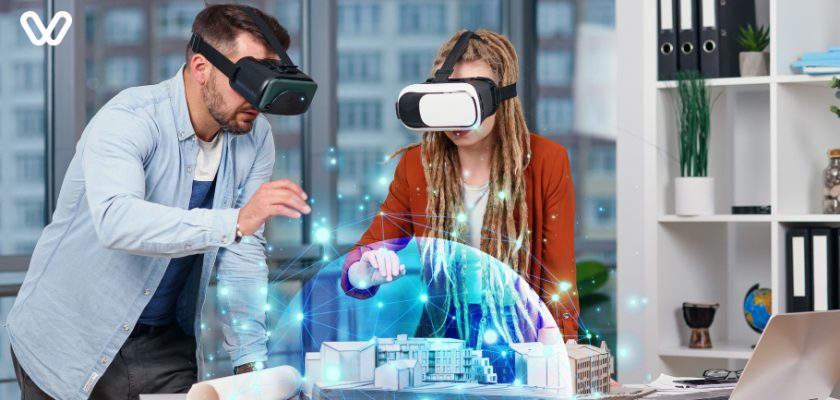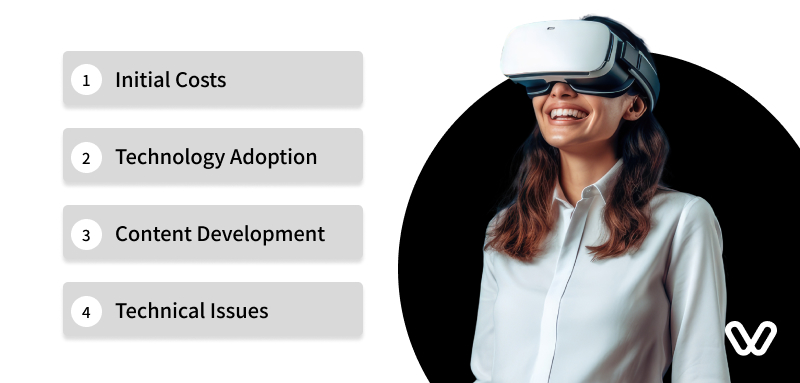Have you ever thought of a virtual world where you can perform intricate surgeries, navigate complex machinery, or pilot an aircraft—all without any real-world consequences?
If yes, then you are not daydreaming. Due to the transformative power of virtual reality (VR), this is not science fiction but a growing reality in training and development.
A report by PwC found that employees trained with VR learn four times faster than traditional classroom learners. This guide discusses VR’s impact on training and development across various sectors, making learning more immersive, engaging, and effective than ever before.
Understanding Virtual Reality (VR)
Virtual Reality is a type of technology that creates an immersive world. People can feel like they’re really there and do things like they would in real life.
They wear special goggles called VR headsets and sometimes use other things like gloves or sensors to make the experience more real.
This lets them see and hear things that aren’t really there, making it seem like they’re in a different place altogether.
In VR, you wear a special headset with screens for each eye. This makes things look 3D like they’re really far away or close up.
Sensors in the headset follow how you move, so when you turn your head, the view changes like you’re looking around a real place.
Some VR systems also give you a feeling of touch, making the experience even more real.
Nowadays, the impact of VR on training isn’t just for playing games or having fun. It’s used in many different areas, especially for teaching and learning by investing in employee development.
Industries like healthcare, manufacturing, aviation, and corporate are using VR training programs to make employee learning and development better and more interesting.
Benefits of VR in Training and Development
Using virtual reality employee training and development is changing how companies get their employees ready. Here are some important impacts of VR on training and reasons why VR is so useful for training today.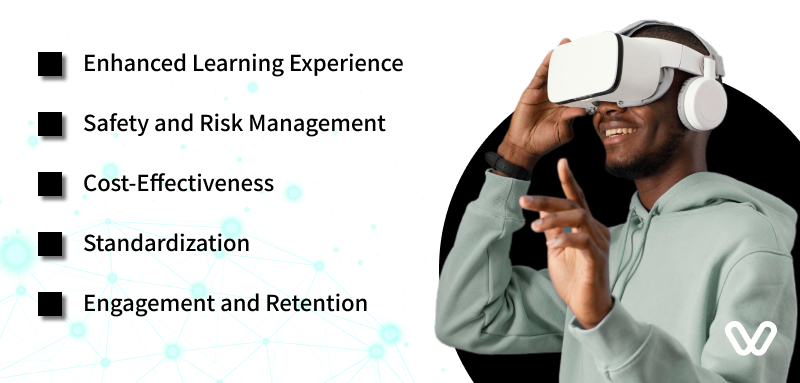
Enhanced Learning Experience
VR makes learning more interesting by letting users be part of the action. Trainees can practice skills in a way that feels real, helping them understand better and remember more.
Safety and Risk Management
A big advantage of virtual reality training is that it can create dangerous situations without any real danger. For example, medical students can practice doing surgeries without actually operating on anyone, and pilots can practice what to do in emergencies without being in a real airplane.
Cost-Effectiveness
Although getting started with VR can be expensive, it usually saves money in the long run. The impact of VR on training can be seen without needing physical stuff or places, and you can do the simulations as many times as you want without paying extra.
Standardization
The impact of VR on training makes sure that everyone gets the same training, so everyone learns the same things and practices the same skills. This helps make sure that everyone achieves the same results in the end.
Engagement and Retention
Research proves that the impact of VR on training gets people more interested and helps them remember things better. Because VR feels so real, it’s more fun and easier to remember what you learn, which means you’ll remember it for a long time.
These benefits show the impact of VR on training in different industries. Using VR helps organizations make learning better, safer, and more interesting for their employees.
Industry-Specific Applications
Virtual Reality is used in many industries, and each one finds its own special ways to benefit from it. Let’s see impact of VR on training in different sectors to make their training and development programs even better.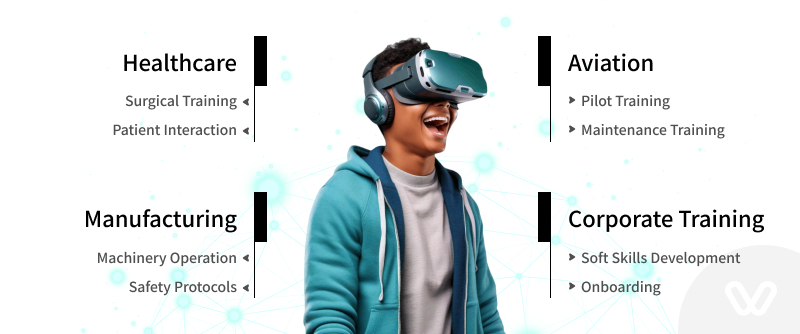
Healthcare
- Surgical Training: VR allows medical professionals to practice surgeries in a risk-free environment, honing their skills without any consequences for real patients.
- Patient Interaction: Healthcare providers can use VR to role-play different scenarios, improving their communication and bedside manner with patients.
Manufacturing
- Machinery Operation: Trainees can learn to operate complex machinery through VR simulations, reducing the need for downtime in actual production environments.
- Safety Protocols: Workers can practice emergency procedures, such as dealing with equipment malfunctions or hazardous material spills, in a controlled and safe virtual setting.
Aviation
- Pilot Training: Flight simulators provide pilots with realistic flying experiences, allowing them to practice maneuvers and handle emergencies without any risk.
- Maintenance Training: Technicians can perform virtual inspections and repairs, gaining hands-on experience without affecting actual aircraft availability.
Corporate Training
- Soft Skills Development: VR scenarios can help employees develop leadership, communication, and teamwork skills by placing them in interactive, real-life situations.
- Onboarding: New hires can be immersed in the company culture and processes from day one, making onboarding more effective and engaging.
These examples show the impact of VR on training and how it can be used in many different areas of training. As VR gets better and better, it will keep changing how we train people and make things even better.
Challenges and Considerations
Even though the impact of VR on training and development is tremendous, there are some problems that organizations need to solve.
It’s important to understand these issues to make sure that VR works well when it’s used.
Initial Costs
The cost of getting VR equipment and setting it up can be quite high. Organizations have to think about these expenses and decide if the benefits they’ll get in the long run are worth it.
Technology Adoption
Some employees might not want to use new immersive learning technologies because they’re worried about learning how to use it. It’s important to manage this change well and give proper training to make sure the new technology works out.
Content Development
High-quality VR content that fits the industry is really important for training to work well. However, making this content can take a lot of time and money.
Technical Issues
Sometimes, things can go wrong with the technology used for training, and it might need fixing. Organizations need to be ready to solve these problems quickly so that training can keep going without too much interruption.
If organizations understand and get ready for these challenges, they can be more prepared to use VR in their training. With good management, they can still get all the benefits of VR, even with these problems.
Future of VR in Training and Development
The future and impact of VR on training and development seem bright, with more improvements coming soon. Here are some important trends and guesses about how VR will change training in the future.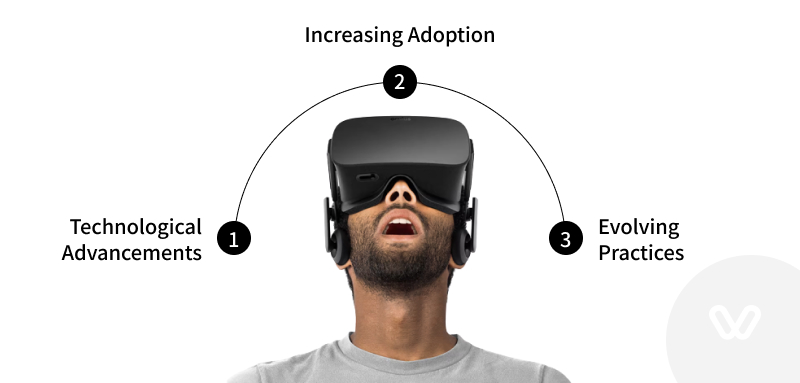
Technological Advancements
New inventions in VR gadgets and programs will make them easier to use and better. Headsets will be lighter and more comfy, and the pictures will look even nicer, making VR more fun for everyone.
Increasing Adoption
As VR gets cheaper and more people see how useful it is, more companies will start using it. Experts think that VR will become a normal thing to use in training and development programs everywhere.
Evolving Practices
With VR getting better, the way we teach people will also change. Training will be more about each person, fitting their needs and how they like to learn.
These improvements show that VR will keep getting more important in training and development. As technology gets better, VR’s future challenges preparation will probably become a big part of how we teach, giving us new and better ways to learn.
Final Words
Virtual Reality is reshaping the training and development arena across diverse industries. Its capacity to deliver immersive, captivating, and secure learning environments provides unmatched benefits.
As technology progresses and its adoption spreads, VR is poised to become indispensable in shaping the workforce of tomorrow.
Ready to explore the potential of Virtual Reality for your training needs? Join Vinove today to explore the impact of VR on training programs and prepare your workforce for the challenges ahead.
